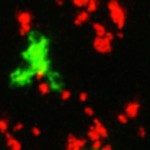Link to Pubmed [PMID] – 24614106
J. Clin. Invest. 2014 Apr;124(4):1711-22
Nitric oxide (NO) production is critical for the host defense against intracellular pathogens; however, it is unclear whether NO-dependent control of intracellular organisms depends on cell-intrinsic or cell-extrinsic activity of NO. For example, NO production by infected phagocytes may enable these cells to individually control their pathogen burden. Alternatively, the ability of NO to diffuse across cell membranes might be critical for infection control. Here, using a murine ear infection model, we found that, during infection with the intracellular parasite Leishmania major, expression of inducible NO synthase does not confer a cell-intrinsic ability to lower parasite content. We demonstrated that the diffusion of NO promotes equally effective parasite killing in NO-producing and bystander cells. Importantly, the collective production of NO by numerous phagocytes was necessary to reach an effective antimicrobial activity. We propose that, in contrast to a cell-autonomous mode of pathogen control, this cooperative mechanism generates an antimicrobial milieu that provides the basis for pathogen containment at the tissue level.

